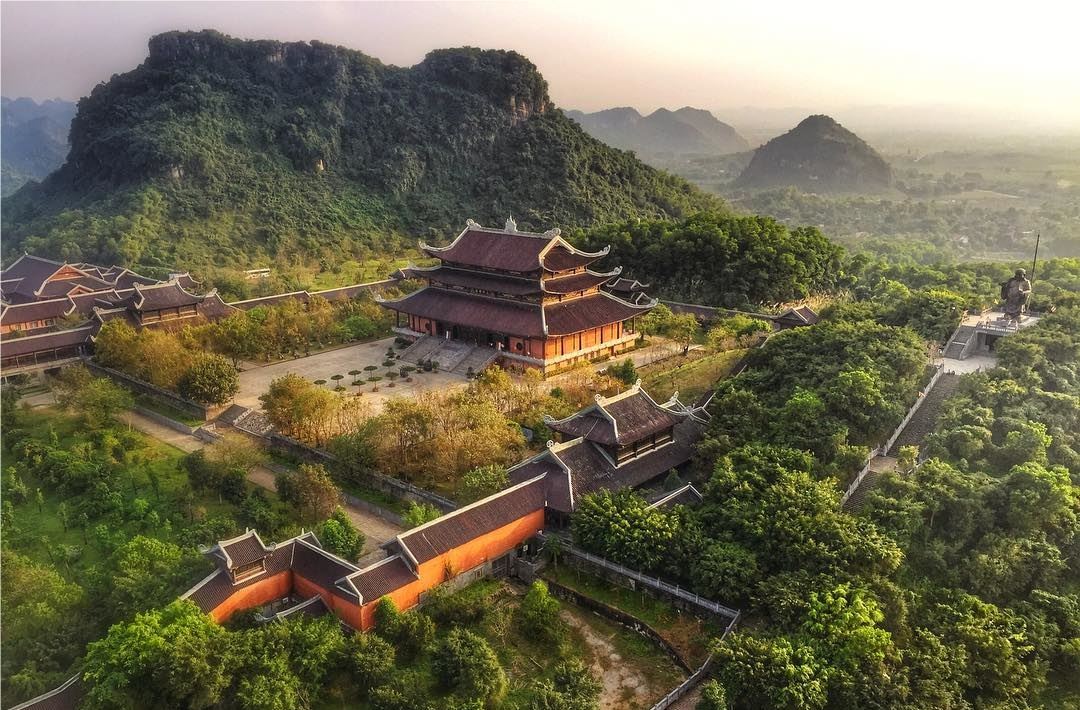Ninh Binh is known by tourists near and far as a famous spiritual tourist destination. This place has a mesmerizing complex of Trang An scenic spots and many sacred ancient temples. This is also the land of "human spirits" because it has given birth to many outstanding heroes of the nation and was once the capital of the Dinh, Tien Le and Ly dynasties.

Photo: Vietnam.vn
Bai Dinh Pagoda located on Bai Dinh mountain in Gia Sinh commune, Gia Vien district, Ninh Binh province, only 6km from Hoa Lu ancient capital, 15km from Ninh Binh city and 100km from Hanoi capital. Located in the middle of a vast valley, surrounded by superficial limestone mountains, Bai Dinh Pagoda is one of the most important attractions of Trang An eco-tourism complex.
According to the ancients, "Bai" means to worship heaven and earth, Fairy Buddha; "Ding" is the top, at the top. The name "Bai Dinh" means to worship heaven and earth, showing people's reverence for heaven and earth. With a majestic landscape favored by nature and a history of more than 1000 years, Bai Dinh Pagoda annually welcomes tens of thousands of Buddhists to pilgrims as well as visitors.
Bai Dinh Pagoda has a campus of 539 hectares, including 27 hectares of the ancient Bai Dinh pagoda area and 80 hectares of the new Bai Dinh pagoda area. The pagoda was built in many different stages, bearing the imprint of Vietnamese architecture.
The ancient Bai Dinh Pagoda was built by Zen master Nguyen Minh Khong in 1136. The nearly 1000-year-old pagoda still has sacred relics such as: Jade Well, Ancestral Cave, Buddha Cave, Mother Cave, Cao Son Holy Altar... Located on a 187m high mountain, the ancient pagoda is about 800m southeast of the new pagoda. The entrance to Bai Dinh ancient pagoda is 300 flat stone steps.

Photo: Vietnam.vn
The new pagoda was built in 2003 on an 80-hectare site that includes various highlights such as the Jade well, the bell tower, the main hall and the corridor with 500 Arhat statues.
With a length of 1,700m, the Arhat corridor of Bai Dinh Pagoda is the longest corridor in Southeast Asia. The corridor consists of two routes starting from Tam Quan Noi gate to Ta Vu and Huu Vu houses. 500 Arhat statues are carved with monolithic blue stone, elaborately carved by artisans in Ninh Van stone village, Hoa Lu. Each statue is an average height of 2.5 m and weighs between 2 and 4 tons. 500 statues are 500 different versions. The front pedestal of the 500 Arhat statues is engraved with the name of each Arhat in both Vietnamese and Chinese below.
The new Bai Dinh Pagoda includes many large-scale and unique architectural works such as: Three Gates, Bell Tower, Quan The Am Temple, Buddha Pagoda.
Carrying many historical, cultural, and architectural values, Bai Dinh Pagoda is the temple with the most records in Vietnam. Up to now, there have been 8 records recorded: The largest gold-plated Shakyamuni Buddha statue in Asia: Shakyamuni Buddha statue weighing 100 tons at Dharma Chu Pagoda; The largest bronze Buddha statue in Southeast Asia: Maitreya Bodhisattva statue weighing 100 tons; The largest bronze bell in Vietnam: the bronze bell weighs 36 tons in the bell tower; The largest pagoda area in Vietnam: 539 hectares; The longest corridor with 500 Arhat statues: two wooden corridors with a total length of 3,400 m; The largest number of Arhat statues in Vietnam: 500 Arhat statues made of blue stone; The largest Pearl Well (pearl) in Vietnam: 30m in diameter, 6m deep; The largest number of linden trees in Vietnam: 100 trees

Photo: Vietnam.vn
The Bai Dinh pagoda complex has two main areas: the ancient pagoda area with ancient relics and the new pagoda area.
Bai Dinh Pagoda is shaded with trees all year round. The campus is covered with paths with greenery. The most abundant is the linden tree. These Bodhi trees are extracted from temples in India.
From January to March of the lunar calendar is the most suitable time to visit Bai Dinh Pagoda because the weather is spring, cool and not too sunny. This is also the festive season at Bai Dinh Pagoda.
Synthetic Migo
